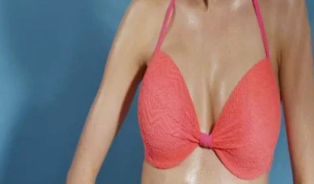Not all young women, girls, and middle-aged women are happy with the shape of their breasts, many complain of losing their original shape and elasticity.
Elevation with hyaluronic acid is a minimally invasive procedure in which soft tissues remain intact. This is a real opportunity to adjust to a size to give the chest a natural appeal. Injections are performed under local anesthesia, the positive result is transient.
What is the purpose of the procedure
Although breast augmentation with hyaluronic acid is simple, it is not designed for all women. You can do this with the following factors:
- Up to 1 size should be increased
- to eliminate mammary asymmetry,
- correction after implant placement.
In other cases, the use of such a method for breast augmentation in women is not appropriate.
How to increase breast with hyaluronic acid?

Hyaluronic acid has been used for cosmetic purposes for breast growth and enlargement for more than ten years. Hyaluronic acid is an artificial drug, but is recognized as the safest and best quality substance to help eliminate cosmetic blemishes in the female body.
The formula of hyaluronic acid completely coincides with the natural substance formed in the human body. Its introduction usually does not cause any side effects and allergic reactions and has no negative effects on a woman’s health, there are virtually no rejection facts.
Hyaluronic acid has a rather viscous structure, thanks to which, when fillers are injected under the skin, it reliably fills the cavities in the deep layers of the dermis and stays there for a while, optimizing the processes inside the muscles.
Breast augmentation with this tool is based on the fact that an acid molecule is able to attract and retain hundreds of water molecules.
In addition, the property of hyaluronic acid to activate fibroblasts, which are responsible for the regeneration of collagen fibers, has been established. As a result, after the procedure of introducing the acid into the mammary gland, the elasticity of the skin increases and its tone also increases. Shortly after insertion, a process of degradation occurs, and breast-enlarging substances are disintegrated and excreted by the flow of lymph.
Procedure procedure
Only highly qualified professionals should be able to correct the injection using hyaluronic acid and have an official certificate (diploma, license or standard certificate).

Breast augmentation with hyaluronic acid can take about 1-1. 5 hours. Prior to injections, antiseptic treatment of the skin and local anesthesia are performed.
The medicine is injected under the fascia of the breast. In some cases, it is more appropriate to introduce it into the area of the anterior axillary line. A micro-incision is made in the skin (approximately 2 mm each) and, after the acidic injection procedure, its edges are fixed with a single suture.
The amount of drug required is determined during the procedure.
After visual inspection and palpation, the beautician can correct your introduction. In women with breast augmentation with hyaluron, the end result can only be assessed at the end of the rehabilitation period. This time about 2-3 weeks after the procedure. The total period for saving the result of the procedure is 1-1, 5 years.
Postoperative breast care
A breast augmentation procedure with such an injection does not require a long rehabilitation time. The patient may soon return to his daily life.
But despite mild invasiveness, injections require post-rehabilitation rehabilitation measures. This period can last up to 3 weeks, depending on the individual characteristics of the patient.
It is recommended to refrain from visiting steam baths and saunas during the rehabilitation period to avoid complications. Doctors advise you not to stay in the solarium and pool water. Physical activity should be minimized. In order for the microcuts to heal quickly and to introduce the filler, these skin surfaces are treated with antiseptics.
To speed up the rehabilitation process, do not wear too tight clothing, including a bra on your chest, during the postoperative period. Synthetic clothing is not recommended. Doctors recommend that patients who have undergone breast augmentation with this technology sleep on their backs so that they do not compress their pectoral muscles during sleep. To support your mammary glands during your rehabilitation period, you need to buy a special bra that gently supports your breasts.
Existing contraindications
Breast augmentation by injection using hyaluronic acid is prescribed to patients who do not have health problems. It is not recommended to perform such an intervention for women with the following pathologies and body characteristics:

- Presence of oncological diseases (at any stage of the disease),
- in the worsening of chronic diseases of the internal organs,
- throughout pregnancy,
- while breastfeeding,
- Presence of autoimmune diseases,
- diabetes,
- inflammatory processes in the skin, including the presence of rashes on the body.
Before deciding whether it is possible to perform breast augmentation surgery with hyaluronic acid, your doctor will consider other relative contraindications. Although they do not pose a risk to a woman's health, the outcome of the procedure will be minimal:
- Breast prolapse is too obvious
- Lack of skin elasticity,
- menstrual period,
- the patient's desire to become pregnant in the near future
- breasts are larger than the third size of bra cups,
No breast augmentation procedure is performed if the patient plans to have it enlarged to more than 1.
Complications and side effects
As a general rule, breast augmentation with hyaluronate occurs without further complications and side effects. But in the first two days after correction, there may be moderate pain, edema, and blue discoloration of the skin at the incision site. In rare cases, there is a slight increase in body temperature.
Only a few women experience more serious complications after the procedure. With the unique feature of pectoral muscle structure, injected acid sometimes spreads. The gel migrates in the intermuscular space, leading to asymmetry.
If the technology is violated during the acid injection, it can lead to inflammatory reactions in the body and even necrosis.
Cost of the procedure
Such a cosmetic procedure for supplementing with hyaluronic acid is a relatively expensive procedure. Its cost depends directly on the amount of filler injected, the prestige of the clinic and the qualifications of the specialist.


























